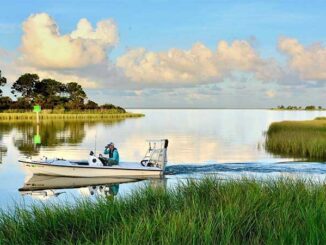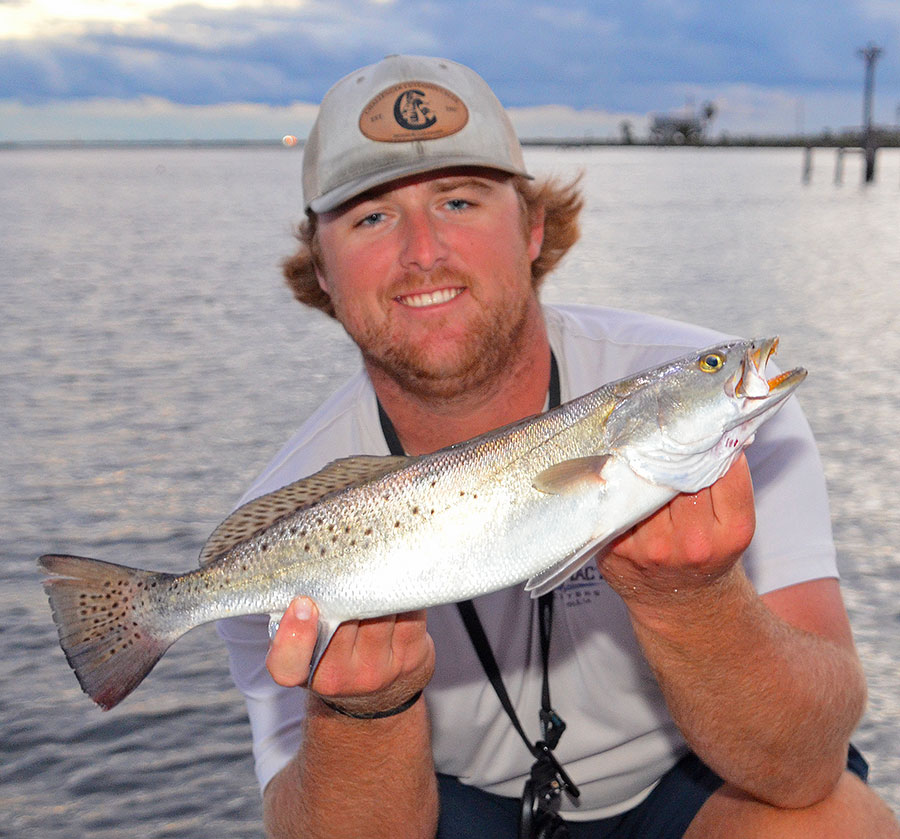
Understanding the seasonal trout run helps anglers have more fun
Among the most prolific and popular game fish in Louisiana coastal waters, speckled trout grow fast and produce millions of offspring. Spawning peaks from mid-May to June with a smaller peak in August.
“We generally consider the trout spawning season to run from about April through September,” said Jason Adriance, the Finfish Program Manager for the Louisiana Department of Wildlife and Fisheries in New Orleans. “That’s when they start to move from inshore down towards saltier waters in the Gulf of Mexico.”
To survive, trout eggs require salty water so eggs remain buoyant and viable. When spawning time approaches, trout head toward saltier waters. Away from major freshwater influences like the Mississippi River, Gulf salinity levels average about 25 to 35 parts per thousand.
“Typically, in Louisiana, trout like to spawn in water at least 15 parts per thousand of salinity or higher,” Adriance said. “In lower salinity levels, egg buoyancy becomes an issue.”
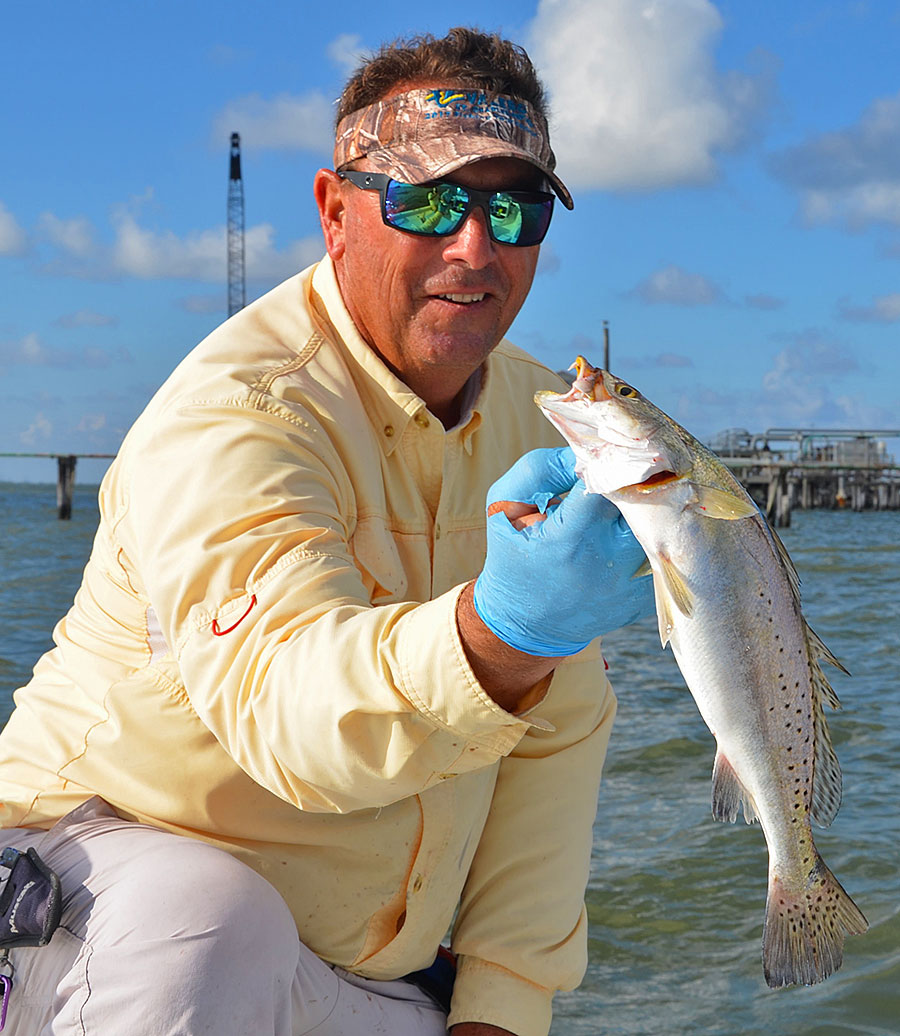
Reproductive potential
Speckled trout females can begin reproducing when they reach about 10 to 14 inches long. Normally, that’s about 12 to 18 months old. Exactly when a young female trout might spawn for the first time largely depends upon when she originally hatched. For instance, a Louisiana female that hatched in May 2023 would likely measure about 10 inches long by May 2024. She could make her first spawn in late summer 2024. The peak in August comes from fish that spawned the previous summer just coming into their reproductive potential.
“Some trout reach sexual maturity when they are about 10 inches long,” Adriance said. “That’s roughly a year old. Not all 10-inch fish will be mature enough to spawn. Some won’t spawn until they are about 14 inches long. The closer we get to the 14-inch mark, the closer we get to 100 percent maturity. Just because a female trout can spawn doesn’t necessarily mean she will. Younger fish don’t spawn as often as older, bigger fish.”
Unlike bass or bluegills, speckled trout do not make nests. A member of the drum family, along with redfish, black drum, white trout and croakers, male specks generate a drumming sound to call the females to them. Hundreds, perhaps thousands, of drumming males congregate in places with good salinity and tidal flow, usually at night.
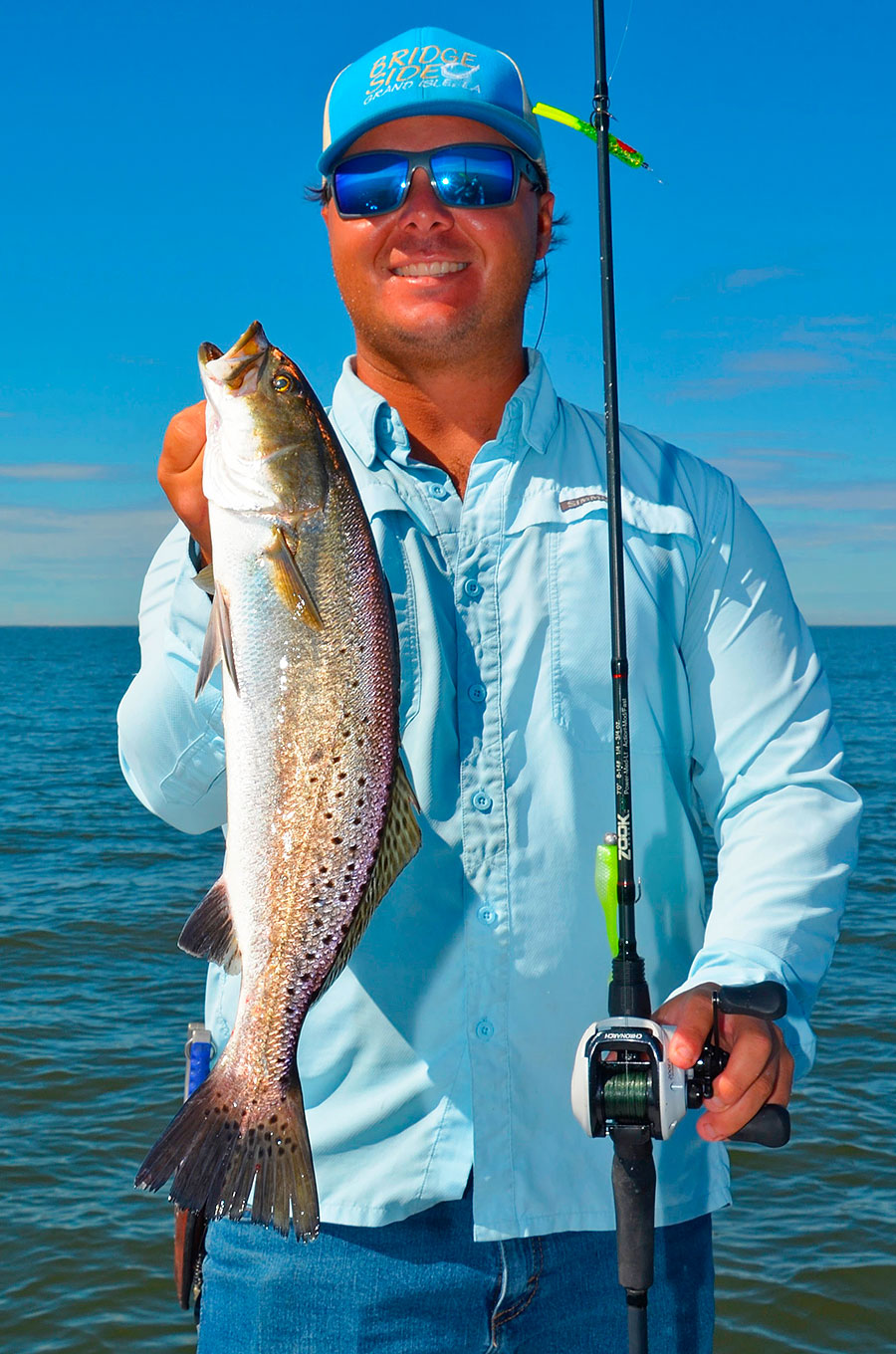
Growing trout
Males fertilize the eggs as the females release them. Then, males and females separate. About 18 hours later, eggs hatch into larvae about 1/16 of an inch long. Rising tides carry the eggs and larvae toward the marshes and other places where they can find protective cover to hide from multitudes of predators. If it survives, a juvenile trout would reach about two inches long in six to eight weeks. Growing trout stay in the marshes about a year.
Each female trout could release a batch of eggs about once every seven days for months. Larger trout naturally lay more eggs than young, small trout. A five-year-old female could produce five times as many eggs as a yearling. One four-year-old female could lay more than 685,000 eggs at a time and produce millions of offspring.
“Younger, smaller fish might not spawn as many batches as some bigger or older fish,” Adriance said. “We estimate that a 12-inch Louisiana trout might spawn five million eggs in a year. A 14-inch fish will spawn nearly eight million a year and a 20-inch fish will spawn more than 20 million eggs a year.”
Although one large female speck might lay millions of eggs, perhaps only four to five percent of the hatchlings live long enough to spawn one time. Few make it to five pounds. Very rarely does a trout surpass eight pounds and even less 10 pounds. Besides fishing pressure, trout face countless natural threats and commercial bycatch waste.
“Very few trout live to reach 15 inches,” Adriance said. “There’s high mortality on those eggs from the start and very few survive. Very few fish make it to four or five years old, because of both natural and fishing mortality. Hopefully, the new regulations will help bolster the trout spawning population.”
New regulations
Under the new Louisiana laws regarding specks, anglers can keep up to 15 fish a day, each at least 13 inches long and only two fish longer than 20 inches in total length. When fishing with a charter captain, the captain cannot keep a limit. A three-year-old female speck should measure about 17 inches long, and a male about 13 inches.
“In Louisiana, trout can live to be about nine or 10 years old, but the actual structure of our population doesn’t have very many fish that are three years old or above,” Adriance said. “Currently, we have very few 20-inch fish in the system. The majority of our speckled trout stock are one-year old fish and some two-year-olds.”
With trout beginning to congregate in schools, May offers anglers one of the best times to catch trout anywhere in the state. Anglers might also catch their biggest fish all year.
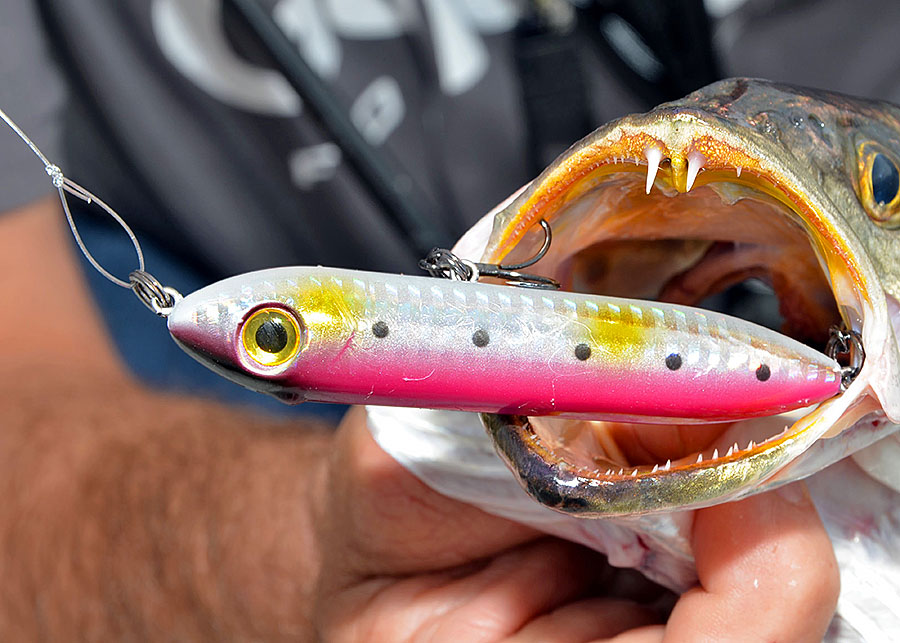
“May is a great month to fish for speckled trout, especially the bigger ones,” said Kirk Stansel with Hackberry Rod and Gun (1-888-762-3391, www.hackberryrodandgun.com) on the Calcasieu Estuary in Hackberry. “Traditionally, May is a really good month to catch big trout. They are starting to spawn. Ones that haven’t spawned yet are big, fat and full of eggs. Over the years, that’s when we’ve caught most of our big trout, those in the seven- to 10-pound range.”
With the water rising into the upper 70s and 80s across the state’s coast in May, trout turn more aggressive. They need to stock up on protein and calories to power them through the arduous spawning period. At this time, anglers can catch trout with just about any method they would like to try.
“In May, we can catch trout in the shallows, out on the reefs, on the points, passes and cuts everywhere,” Stansel said. “It’s the month when things get kicked off. In May, the birds start working so people can catch a lot of schooling fish. We might catch a nice one every now and then in a school, but most of the fish under working birds will be school trout.”
In the spring, the estuaries start filling up with bait. Shrimp start moving back into the bays and estuaries. Menhaden, also called pogies, and mullets become plentiful. Frenzied speckled trout in large schools push the bait toward the surface to cut off their escape. From the air, sharp-eyed birds instantly spot any activity and swoop down to get their share of the bounty.
Frenzied fun
When frenzied trout get in a massive school, anglers can catch them on just about anything they throw. Many people fish popping cork rigs sweetened with live shrimp or soft-plastic shrimp imitations. Suspending baits, topwaters and jigs tipped with plastic trailers also work. Put the bait in the right place and almost anything might entice those ravenous school trout.
“I also like to throw suspended baits, like a Corky Fat Boy,” Stansel said. “MirrOlure MirrOdines are also great, as are Soft-Dines. In the spring, I’ll rip a suspending bait hard and work it quickly. Braided line makes a difference when fishing those suspending jerkbaits. We’ll always get more bites with braided line. I put on two or three feet of 30-pound monofilament leader to 30-pound braid main line.”
For the biggest trout, anglers can’t beat topwaters. People might not catch as many trout as they would fishing live shrimp or jigs, but they commonly catch bigger trout on average. For most anglers, nothing gets them more excited than seeing a large fish explode on a surface plug.
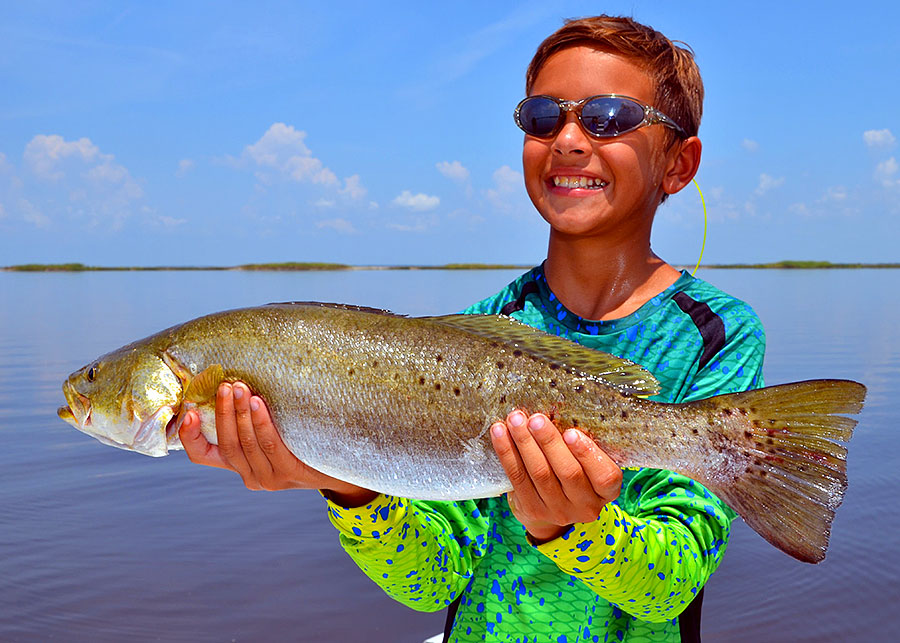
Topwaters come in several varieties, but most saltwater anglers prefer the “walk-the-dog” or walking baits such as Super Spooks, Rapala Skitter Walks and the MirrOlure Top Dog family of floaters. These enticements create a slashing side-to-side action when retrieved and can sail long distances. Since they cover so much water, they make excellent search baits.
“For the biggest trout, I like a Rapala Skitter Walk or a Super Spook,” Stansel said. “We drift around the reefs and throw suspended baits or topwaters and catch bigger trout. I experiment with different retrieves throughout the morning to see what works best that day. If nothing happens with a continuous walking retrieve, try stopping it for a few moments. Trout might want the bait one way today and a different way tomorrow.”
Of course, the old standby, a 1/8- to ¼-ounce jighead tipped with a plastic trailer, puts many trout in the boat. With shrimp-like trailers, let the jighead hit the bottom. Then, pop it up off the bottom and let it sink again. With paddle or “swimmer-tails,” reel steadily. Pause periodically to let the bait sink a foot or two. Try fishing different depths. The faster the retrieve, the higher the bait will run in the water column.
Hopefully, the new regulations and closer study and monitoring of commercial operations will keep more spawning trout in Louisiana waters so these highly prolific and tasty fish will continue to delight thousands of Louisiana anglers for many years to come.


